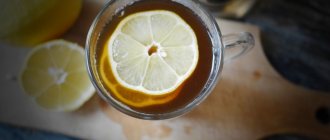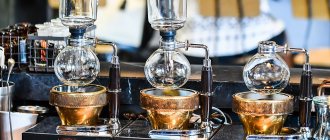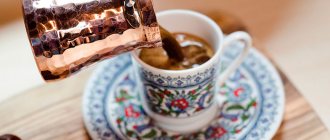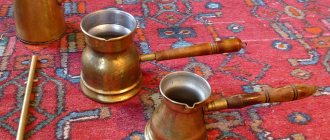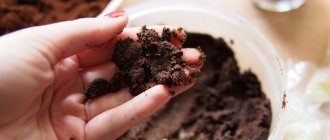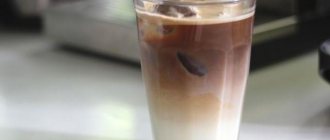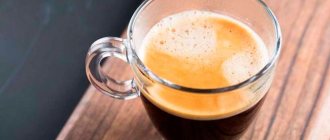Many adults remember being given a delicious coffee drink in kindergarten. This is one of the most pleasant memories of childhood. I have always been interested in knowing the composition of children's “coffee”. And one day I came across his recipe. Now I often delight my children with this drink. It consists of a small amount of available ingredients and is easy to prepare. Coffee drinks for children are absolutely safe as they do not contain caffeine. In this article I will share a classic recipe for children's “coffee”.
Compound
The medicinal properties of a natural product are determined by its composition.
Nutritional value (100 ml):
- kJ - 12.6;
- kcal - 3;
- proteins - 0.2 g;
- carbohydrates - 0.1 g;
- water - 99 g.
Can children drink coffee - what are its benefits?
Consumption of natural energy drinks in appropriate quantities has a beneficial effect on the psyche, increases attention, concentration, physical and mental performance (important for teenage schoolchildren during exams). Caffeine improves mood, feeling of well-being, helps get rid of headaches
Positive effects:
cleansing the body; removing free radicals from the body; cancer prevention; support brain function (temporarily); improvement of attention, ability to remember (temporarily); calming the central nervous system; natural antidepressant; diabetes prevention; prevention of vascular and heart diseases; increased blood pressure (caution!); defecation support; improvement of metabolism; cleansing the colon as it passes through the intestines; prevention of liver diseases.
Harm, danger of coffee
In addition to the positive effects of the natural drink, it is worth mentioning the adverse effects that occur in the body (the frequency of manifestations varies from person to person).
Side effects include sleep disturbances. Caffeine reduces the quality of sleep (therefore you should drink the drink in the morning and in the first half of the day), promotes diuresis (diuretic effect), and increases blood pressure (1-2 mmHg).
Excessive consumption can cause digestive problems and abdominal pain.
addictive
The alkaloid caffeine is a pharmacologically active substance that stimulates the central nervous system. In addition to its positive effects, it is described as a “potential drug.” But restrictions on use are not determined by the responsible authorities.
The WHO concluded that there is no evidence that caffeine consumption leads to the effects that occur when taking addictive substances. The American Psychiatric Association said the substance did not meet criteria for being associated with drug addiction.
Therefore, if addiction exists, then withdrawal symptoms after cessation of use are minimal or unnoticeable.
Effect on the body
When a person drinks coffee, caffeine enters the body, is broken down into chemicals by liver enzymes, and then travels throughout the body, affecting the brain.
A substance similar to adenosine that affects the sleep-wake cycle. When adenosine combines with a sufficient number of receptors, signals are sent to the brain about the onset of sleep and rest. When drinking the drink, caffeine molecules bind to adenosine, preventing it from connecting to receptors. It does not replace the need for sleep, but relieves the feeling of fatigue and drowsiness. Therefore, there is a feeling of fresh energy.
Expert opinion: “Don’t forbid your child coffee!”
Parenting forums are replete with the most contradictory information: some say that coffee poses a serious danger to children, others advise coffee in small doses because it contains a lot of beneficial properties, and others call for both adults and children to give up caffeine altogether. According to doctors, there is no need to go to extremes - everything is good in moderation.
Pavel Pronichev, general practitioner: “Coffee itself is not harmful to children. The caffeine contained in the drink, of course, excites them and irritates the stomach, but the content of this substance is much higher, for example, in green tea. Therefore, there is nothing wrong with a small cup of weak natural (but not instant) coffee diluted with cream or milk. Soviet pediatrics did not prohibit coffee in children's diets, but did not recommend it either. My eldest son, who is 8 years old, sometimes drinks weak brewed coffee with sugar and milk. If your child is already in school and shows interest in an "adult" morning drink, don't stop him from drinking it. Let him try for his health!”
Drink to activate strength and mental activity
Coffee is truly a miraculous drink. It stimulates brain activity, improves memory, allows you to absorb more information, feel cheerful and full of energy, increases endurance and reaction speed, activates the gastrointestinal tract (if you or your baby do not have stomach problems) and simply improves mood .
Of course, you need to follow strict rules, because even an adult, excessively strong coffee in large quantities has a detrimental effect. And a student shouldn’t turn drinking coffee into an everyday ritual; it’s better to come up with a special coffee ritual that will take place once or twice a week and can turn into a real holiday.
Recipe for “activating” coffee:
We brew two teaspoons of natural coffee in a cezve, at this time we bring two teaspoons of cocoa powder, two tablespoons of brown sugar and 100 grams of milk to a homogeneous consistency.
“Mom, today in kindergarten we were treated to a coffee drink, it’s so delicious” - the words of a contented lisping toddler instantly transport you to childhood. At that time, which smelled deliciously of “cock on a stick”, sugar toffees, condensed milk, and yes - . We may have trouble remembering many things and events, but the smells are good - they are not so easy to erase from memory. We drank a coffee drink, imagining that it was real coffee, and we were those same business adults. We dreamed of growing up quickly, naive. But this was a lyrical digression, the author’s trick to further “immerse” the reader in the topic under consideration. Let's take a closer look at what a coffee drink is and what it is eaten with? What is its composition and does it harm our children? Let's find out!
Let's look at the composition
Don't be alarmed; coffee in children's coffee drinks is only in the name. There is no natural coffee in most formulations; it is usually replaced with the following components:
- Chicory;
- Rose hip;
- Barley;
- Acorns;
- Chestnuts;
As can be seen from the list, the composition is very harmless.
Giving a coffee drink to children over two years of age is allowed, the daily norm is no more than 1 cup per day. If the child is not allergic to its constituent components, “surrogate” coffee (it is also called that) will not only not harm the child, but will also saturate the child’s body with the necessary vitamins and microelements. For example, chicory is able to balance the unstable nervous system of children, rose hips have a general strengthening effect. A coffee drink can normalize the intestinal microflora, remove toxic substances (due to oligosaccharides and pectins in its composition), and improve appetite, which is especially important for those with little appetites. The oats included in the composition contain a large amount of protein, which is simply necessary for a rapidly growing child's body, barley contains B vitamins and magnesium.
Sometimes natural coffee is included in the drink. Parents should not worry about this: firstly, the amount is usually insignificant, and secondly, caffeine has an invigorating and tonic effect on the body. If consumed in moderation, it will not cause any harm to the baby’s body. But you should know that an overdose of a drink that contains natural coffee can lead to leaching of calcium from the body (this is a property of caffeine) and provoke increased excitability
Please note that you should avoid drinking this drink in the evening.
Let's consider the nutritional indicators given in the technological map of the drink. So, KBJU of surrogate coffee per 100 grams:
- Proteins 1.56 g;
- Fat 1.33 g;
- Carbohydrates 7.1 g;
- Calorie content 46.7 kcal.
- The card also shows vitamins (B1, B2, C) and microelements (calcium, iron).
What is a substitute for coffee?
Coffee drinks for children use surrogates that taste similar to coffee. Most often, such products are made based on the following components:
These ingredients are thoroughly crushed and fried. They taste good and are absolutely safe for children's health.
On store shelves you can find ready-made coffee drinks made from barley and chicory. The most popular brands are “Morning”, “Evening”, “Golden Ear”, “Aroma”, “Summer”. They contain exclusively natural ingredients.
The effect of coffee and cola
Caffeine can give a good shake and invigorate the body - this is a well-known fact. But what happens if cola is mixed with coffee? Cola is an ideal complement to a coffee drink, since soda contains increased levels of sugar, that is, glucose, which is beneficial for brain activity.
The effect of drinking coffee energy drink with Pepsi comes immediately. The following sensations appear:
- clarification of consciousness;
- increased heart rate and pulse;
- increased mental activity;
- disappearance of fatigue and drowsiness;
- adrenaline production;
- increased performance.
Coffee and cola will give the body a lot of energy
Who can take energy drink?
It is recommended not to drink energy drinks with coffee unless absolutely necessary. It is better to drink this drink in especially emergency cases. People and situations in which drinking coffee energy drink with Pepsi is possible and beneficial:
- Night shift workers, especially those with mechanical and routine work. When you constantly need to monitor cameras and answer monotonous calls. This drink will be a salvation for workers unloading or engaged in other physical activities at night.
- Students, especially during exams. Constant cramming and preparation for the session is exhausting. Constant stimulation of mental activity is necessary. Coffee with cola is an excellent substitute for expensive ready-made energy drinks for students who are always strapped for cash.
- Athletes. Consuming an energy drink immediately before training increases endurance and effectiveness of the workout. This drink, in addition to athletes, is suitable for ordinary people who periodically play sports.
- Active people leading nightlife. After a long day of work, sometimes you want to take your mind off your problems and have fun with friends. You just need to rest after a stormy night the next day.
- Drivers. A night trip can be fatal, so you need to quickly eliminate drowsiness and cheer up.
Just don’t drink the drink often, as it has many contraindications.
Contraindications
Despite the positive feature, such as giving a feeling of vigor and fullness of strength, Pepsi with coffee, like any other energy drinks, has a number of contraindications. For some categories of people, drinking this drink can be especially dangerous.
Persons who are contraindicated from drinking coffee energy drinks with cola:
- pregnant women;
- women who are breastfeeding;
- small children and adolescents under 14 years of age;
- having diseases of the cardiovascular system;
- people with allergies or individual intolerance to certain ingredients of the drink;
- having kidney problems;
- people with nervous system disorders.
The drink has a number of contraindications
Even in the absence of these contraindications, a person may feel unwell after drinking the drink. The following effects may occur:
- cardiopalmus;
- dizziness;
- visual impairment;
- nausea;
- frequent urination;
- disorders of the gastrointestinal tract.
If these ailments do not go away after 2 hours, you should consult a doctor.
Why children should not drink natural coffee
Coffee negatively affects a child's well-being. The main component of coffee, caffeine, is a powerful stimulant. When consuming an extracted coffee drink from natural beans, it enters the body in significant quantities.
From coffee, a baby can become nervous, whiny, and easily excited by any minor event. The systematic intake of caffeine into a fragile body develops persistent sleep disturbances. Nervous excitement is extremely dangerous due to excessive consumption of energy, and therefore nutrients. Thus, coffee consumption at an early age leads to delayed physical development and disturbances in the normal mental state, including:
- Violation of salt metabolism. As a strong diuretic, caffeine promotes frequent urination, which in turn flushes a large amount of beneficial substances from the body.
- Heart rhythm failure. Caffeine can cause arrhythmia. This condition causes chest discomfort or pain.
- Increased secretion of gastric juice and the development of early gastritis.
What can replace coffee for children?
Against the background of such a picture, the answer to the question “what do they give children in kindergarten?” becomes obvious. Children receive a surrogate, or coffee substitute. The drink contains natural ingredients of plant origin - barley, chicory, acorns, soy. All ingredients go well together and taste great individually. In most cases, the products are fried and finely chopped before consumption.
In the store you can find ready-made powder surrogates. Their recipes were developed in distant socialist times and still remain unchanged. All components are absolutely safe, because completely natural. You can purchase the extract in retail chains (less often in a supermarket). The following names will appear on the packaging:
- "Morning". Barley-rye mixture with a small part of chicory;
- "Evening". Exclusively roasted barley grain;
- "Fragrance." Drink made from roasted barley and chicory;
- “Golden Ear”, “Summer”. Chicory and barley in equal parts.
It is better for children to replace coffee with chicory
How to make a healthy coffee drink
Rye coffee.
Wash the rye, dry it and fry it in a frying pan (do not overcook it), grind it in a coffee grinder, and brew it like coffee, you can only increase the dose - 2-3 tsp. for 150 g of water.
Jerusalem artichoke coffee.
Wash the Jerusalem artichoke tubers, dry them, cut them into small cubes and dry them in the fresh air for 3-4 days, then dry them in the oven until they turn brown. Store in a dry place. Before use, fry in a frying pan, grind in a coffee grinder and brew like regular coffee.
Sunflower seed coffee.
To 100 g of coffee beans add 100 g of sunflower seeds, fried in a frying pan and crushed in a coffee grinder.
Chicory coffee.
Nature has given us a plant, the drink from which resembles the taste of natural coffee and is not just harmless, but, on the contrary, healing. Lovers of natural coffee can be advised to add chicory to it - and its harmful effects will be significantly reduced. In the past, natural coffee was sold pre-flavored with chicory. Yes, there was pure chicory coffee. Among many nations, in particular the Germans and the Baltic states, chicory coffee is always held in high esteem.
The entire plant is used for medicinal purposes. The roots contain the bitter extractive substance chicorin, inulin, choline, highly soluble in water, proteins, fats, pectin, vitamins C, B1, E, fat, gum, essential oil, resin, tannins, mineral salts and a large number of trace elements.
Chicory preparations have antimicrobial, anti-inflammatory, choleretic, diuretic, sedative, astringent and appetite-stimulating effects. They have a regulating effect on metabolism, somewhat increase cardiac activity and reduce sweating.
A decoction or tincture of the root is used for gastritis, colitis, enterocolitis, liver disease, scurvy, hysteria, dropsy, hemoptysis, constipation, gout, spasmophilia, joint diseases, hypochondria, muscle pain, toothache, gall bladder and kidney diseases, gallstones and kidney stones, to improve digestion, eliminate discomfort in the gastrointestinal tract, liver and spleen, increase appetite, reduce sugar in urine, reduce increased nervous excitability, as a general tonic, for edema of cardiac origin, for diarrhea (even bloody ), diabetes. An infusion of flowers is used as a sedative for disorders of the central nervous system. Fresh juice of the stems is prescribed for anemia.
Hot and aromatic, strong or completely decaffeinated, with spices or cream – coffee is always popular all over the world. This amazing drink can invigorate you in the morning, make the perfect accompaniment to a fresh croissant for lunch and make the evening feel homey. Rarely does an adult deny himself a cup of coffee, but is it worth introducing a child to it? Let's figure out at what age a son or daughter can be introduced to this drink and how best to brew it.
Expert opinion: “Don’t forbid your child coffee!”
Parenting forums are replete with the most contradictory information: some say that coffee poses a serious danger to children, others advise coffee in small doses because it contains a lot of beneficial properties, and others call for both adults and children to give up caffeine altogether. According to doctors, there is no need to go to extremes - everything is good in moderation.
Pavel Pronichev, general practitioner: “Coffee itself is not harmful to children. The caffeine contained in the drink, of course, excites them and irritates the stomach, but the content of this substance is much higher, for example, in green tea. Therefore, there is nothing wrong with a small cup of weak natural (but not instant) coffee diluted with cream or milk. Soviet pediatrics did not prohibit coffee in children's diets, but did not recommend it either. My eldest son, who is 8 years old, sometimes drinks weak brewed coffee with sugar and milk. If your child is already in school and shows interest in an "adult" morning drink, don't stop him from drinking it. Let him try for his health!”
Fact No. 6. About the soluble stimulant
Instant coffee (like many instant products) appeared thanks to the military. They struggled for a long time to ensure that soldiers’ rations included an inexpensive but effective stimulant. At one time, fighters tested compressed tea tablets, but they did not give a noticeable effect. Then pharmacists came to the rescue and offered a new type of coffee - roasted ground beans, pressed into plates and coated with sugar. Alas, the product did not take root in the harsh conditions of army life. After much research, instant coffee as we know it has finally arrived. The technology for its production is quite simple: the grains are fried, crushed and treated with hot water to obtain an extract. It is either dried (coffee powder and granules) or frozen and then vacuum dried (freeze-dried coffee).
Applicable standards
The menu in a preschool institution is developed in accordance with the physiological needs of children corresponding to their age.
The menu is approved by the head of the preschool institution for a period of at least 14 days.
The range of products included in the menu should be based on the national and territorial nutritional characteristics of children and their health.
The meal plan should include breakfasts, lunches, afternoon snacks and dinners.
Breakfast should include :
- Hot dish;
- Sandwiches;
- Hot drink.
In the event that a product is missing, it is allowed to replace it with an equivalent one.
Lunch should consist of:
- Snacks;
- Hot dish;
- Second course;
- Drinks.
The afternoon snack consists of:
- Drink;
- Bakery or confectionery product.
Dinner consists of:
To compile your daily diet you should use :
- Meat and fish products;
- Chicken eggs (served boiled or as an omelet);
- Dairy products;
- Products containing edible fats (vegetable oils and butter);
- Confectionery products;
- Vegetable products;
- Fruits;
- Canned food;
- Juices and drinks;
- Bread;
- Salt.
Methods for making coffee drink
It’s easy to prepare, below is a traditional recipe borrowed from the Internet (the dose is calculated for one serving of the drink):
- Coffee drink 4-5 g,
- Pasteurized milk 50 g,
- Drinking water 50-60 g,
- Granulated sugar 5 gr
- Place the drink in boiling water and bring to a boil. Then you need to let it sit (5 minutes is enough), strain, add hot milk, sugar and boil.
It is not at all necessary to take a ready-made coffee drink; it can be quickly and easily prepared without the help of others.
You need to take 3 teaspoons of barley grains (the larger the grains, the better). It is recommended to wash them thoroughly and dry them completely. Then fry the barley in a very hot frying pan until they darken and the appropriate smell appears. Grind the finished grains in a coffee grinder, pour into a container with water (150-200 ml), bring to a boil and leave for 3-5 minutes. To improve the taste, you can add a spoonful of honey, a pinch of cinnamon or lemon to the drink.
The recipe for surrogate coffee made from acorns is worthy of special attention. The usefulness of such a drink for the child’s body lies, firstly, in the prevention of rickets and scrofula. Ripe fruits selected for autumn are washed, dried, and removed from the shell. Then the acorns, cut into small pieces, are dried in the oven for more than half an hour, crushed in a coffee grinder or blender and prepared like barley, using the method discussed above.
Web sources offer a very interesting alternative to a coffee drink made from the fruit of Jerusalem artichoke (earth pear). Tubers collected in autumn or spring need to be peeled, cut into small pieces, and pour boiling water over them for a few minutes. Then dry and fry in the oven or in a frying pan. Then, according to the principle described a little higher, the Jerusalem artichoke is crushed and boiled. This drink will be useful for all children, but it is especially recommended for those with diabetes. The finished drink needs to be poured into cups and amuse the little ones! Bon appetit!
How to prepare a coffee drink in kindergarten.
1. Savory KEFIR DUMPS INGREDIENTS: ? 1.5 tbsp flour? 1 tbsp kefir? 1 testicle? 3 tbsp. spoons of butter? 2-3 tbsp. l. Sahara? 1/3 teaspoon of soda? 1/4 teaspoon salt? vegetable oil.
Ingredients: Cottage cheese – 500 g. Eggs – 5 pcs. Butter or margarine – 50 g. Raisins – to taste. Zest – from 1 lemon. Semolina – 1 tbsp. spoon with a small pile. Sugar – 100 g. Sour cream – 50 g.
A simple and delicious cupcake without flour or sugar. Now this is the only way I prepare cupcakes! A 3-ingredient recipe that has no analogues... A simple and delicious cake without flour and sugar is my favorite dessert.
Ingredients: 500 g chicken fillet, 300 g all mushrooms (we have champignons), 70 g cheese, 3 tbsp. spoons of cream, 1 onion, salt, pepper to taste. Cut the mushrooms into cubes and fry in vegetable oil with chopped onion, add salt at the end.
This recipe has been tested for years - the best homemade bread I've ever tried! Ingredients: - 650 ml warm water - 2.5 tsp. dry yeast - 1 tsp. sugar - 2 tsp. salt - 1.
Drinks based on kindergarten recipes.
What do kids usually drink in kindergarten?! That's right: milk! And also cocoa, vitamin tea and even coffee for breakfast. Now we will look into the kitchen of a preschool educational institution to learn how to prepare the right children's drinks.
In addition to water, it is very important for children to learn to drink other healthy drinks. Kvass or gas-water are not included in this list. But juice, cocoa with milk and a coffee drink are very often on the kindergarten menu.
In kindergartens in the Urals, Siberia and the Far East, children are also given vitamin tea for the second breakfast. It is prepared from rose hips. And it has long been clear that this is a record holder and a good supplier of vitamin C to our body. This is the tea we will learn to brew correctly. Well, as for cocoa and coffee, I think anyone can make it. I’ll just show you the technology cards for their production.
Total cooking time – 8 hours 0 minutes Active cooking time – 0 hours 15 minutes Price – very economical Calories per 100 g – 7 kcal Number of servings – 5 servings
Classic recipe
Prepare the following ingredients:
- pasteurized milk or cream - a quarter cup;
- purified drinking water - a quarter glass;
- granulated sugar and surrogate coffee drink (of your choice) - a teaspoon each.
Boil the water. Throw powdered coffee surrogate into it. Boil the drink for about 3 - 5 minutes.
Then strain the liquid. Add granulated sugar and milk (cream) to the drink. Boil again for no more than 3 minutes.
Negative effects of caffeine on the child's body
The alkaloid caffeine has both positive and negative stimulating effects on the nervous system. It can increase mental and physical activity, relieve fatigue, and reduce drowsiness. But in large doses it causes depletion of nerve cells. Its effect on the body depends on the type of higher nervous activity, so the dosage of products containing caffeine should be selected individually.
Effects of coffee on the nervous system
Caffeine affects the neurohormone responsible for sleepiness. Thus, it improves the reaction. Increased activity after a cup of hot drink is explained by the fact that caffeine increases blood glucose levels. In addition, it increases the production of two more hormones - adrenaline and dopamine. Adrenaline stimulates the functioning of all organs and systems of the body, but in addition to a surge of strength, it also causes cardiac disturbances and improves mood, but at the same time causes problems with sleep and makes a person easily excitable.
Which of the listed “bonuses” do children need, whose energy is already in full swing? Any mother knows how overexcitement and insomnia exhaust a child. This applies not only to children, but also to adolescents 14 years old, whose nervous system continues to develop.
Removes calcium and disrupts sleep
Not all coffee lovers know that their favorite drink has a fairly strong diuretic effect. The same caffeine is to blame. And due to frequent urination, not only dehydration occurs in the body, but also accelerates the leaching of calcium. It is known that for every 100 mg of caffeine, a person loses 6 mg of calcium. And the lack of this microelement in the baby’s body can lead to disruption of bone formation, slower growth and the occurrence of defects. In addition to calcium, other minerals and vitamins important for the development of a small person are washed away.
Due to the specific effect of caffeine on the nervous system, the child’s sleep is disrupted: he falls asleep more difficult and slower, and often wakes up in the middle of the night.
Addictive
Caffeine affects the reward center in the brain, stimulates the production of dopamine, and also has a bright taste and pleasant aroma. Even adults easily fall into these “traps,” not to mention children, who very quickly get used to the insidious drink and constantly need a new portion. Without receiving the usual cup, the baby will become irritable, capricious and absent-minded, and will feel tired and overwhelmed. Teenagers addicted to coffee are more likely to become addicted to nicotine and alcohol.
The benefits and harms of caffeine
Caffeine is a natural stimulant whose compounds have a positive effect on the functioning of the brain and central nervous system, blocks fatigue and is therefore popular among people.
Products containing caffeine: tea, coffee, cocoa, Coca-Cola, energy drinks, chocolate.
Benefits of caffeine
- Oddly enough, caffeine is useful for those struggling with excess weight because it speeds up metabolism.
- Coffee contains enough antioxidants to fight free radicals in the body.
Ingredients:
| Brewer's yeast | 10 gr. |
| Sugar | 10 gr. |
| Boiled water | 100 gr. |
Take yeast and sugar and grind them thoroughly. Then add 100 ml of boiled water (warm) and put it in a warm place so that the drink begins to ferment.
The yeast drink recipe we offer is served immediately after preparation. The presence of white foam on the surface of the drink will indicate that the yeast has already begun to work and has maximum benefits for the body.
There are many recipes for this wonderful drink; for example, you can prepare it based on yeast and sugar with the addition of honey and lemon. The taste of the drink can also be changed based on your preferences, for example, by adding a pinch of cinnamon.
This drink is drunk when overtired, as well as to prevent colds. It improves vision, hair and skin condition.
Note :
Drinking yeast drink is contraindicated for people with increased gastric secretion, kidney disease and gout. If the functioning of the liver and biliary tract is impaired, the drink can be included in the diet in small quantities. Consult your doctor before use.
Yeast is prescribed orally: for various infectious diseases, furunculosis, diabetes, skin diseases, gastrointestinal diseases, and also for the purpose of disinfecting the vagina. It has been established that liquid brewer's yeast is a strong stimulant of the secretion of gastric glands, improves pancreatic secretion and secretion of intestinal glands, and improves the absorption capacity of the small intestine.
Beneficial effects of brewer's yeast: improved appetite and well-being, weight gain, normalization of gastric secretions, improved motor function of the gastrointestinal tract, increased tone.
Symptoms of yeast intolerance: belching, a feeling of heaviness in the epigastric region, bloating, and sometimes diarrhea. To avoid this, you must first strengthen the digestive tract with vegetable juices, and then, on an empty stomach, drink a little in the morning. After this, eat only when you feel hungry. If these conditions are not met, intolerance occurs.
Contraindications: kidney disease, gout, etc. I would like to note on my own that if the kidneys are normal, then the yeast, on the contrary, supports them, the urine is filtered much better after taking brewer's yeast.
Refreshing and aromatic - Peppermint Mocha
Do you love the sensual combination of chocolate and mint? Then you will definitely love this mint recipe. Start with preparation:
10 ml mint syrup
dark chocolate
double espresso
120 ml milk – for frothing
Start by dissolving a few chocolate cubes in a double boiler. When it becomes liquid, pour it into a tall glass, add mint syrup to it and stir. Now brew a double espresso and add to the chocolate mint mixture. Mix all ingredients thoroughly to combine the mint and chocolate flavors with the coffee. Heat the milk slightly, then whisk with a cappuccino maker and garnish the drink. Bon appetit!
Coffee drink for children
A revelation for coffee lovers will be the fact that the coffee drink that children receive in kindergarten has nothing to do with the generally accepted varieties of coffee (glazed, Americano, espresso, latte, etc.) and even less so with caffeine.
The harm of a coffee drink lies in the sugar content, because a child will refuse to drink unsweetened drinks. Sugar is a high-calorie product that harms children’s bodies: it disrupts the absorption of calcium and iron, causes hyperactivity and sleep disturbances, and causes dental caries. In addition, sugar is addictive, which can lead to weight problems in the future.
At the same time, the coffee drink is more beneficial for the child’s body than harmful. It contains:
- oligosaccharides that form favorable intestinal flora;
- pectin, which promotes rapid elimination of toxins;
- proteins, vitamin B, magnesium and biotin.
However, it is advisable for parents to pay close attention to the amount of tea consumed, since 150 ml of the product contains 20-50 mg of caffeine. It is not recommended to offer coffee drinks to children under two years of age, as this can cause problems with sleep and a weak stomach.
The daily intake is 250 ml per day.
Why children should not drink natural coffee
Coffee negatively affects a child's well-being. The main component of coffee, caffeine, is a powerful stimulant. When consuming an extracted coffee drink from natural beans, it enters the body in significant quantities.
From coffee, a baby can become nervous, whiny, and easily excited by any minor event. The systematic intake of caffeine into a fragile body develops persistent sleep disturbances. Nervous excitement is extremely dangerous due to excessive consumption of energy, and therefore nutrients. Thus, coffee consumption at an early age leads to delayed physical development and disturbances in the normal mental state, including:
- Violation of salt metabolism. As a strong diuretic, caffeine promotes frequent urination, which in turn flushes a large amount of beneficial substances from the body.
- Heart rhythm failure. Caffeine can cause arrhythmia. This condition causes chest discomfort or pain.
- Increased secretion of gastric juice and the development of early gastritis.
What can replace coffee for children?
Against the background of such a picture, the answer to the question “what do they give children in kindergarten?” becomes obvious. Children receive a surrogate, or coffee substitute. The drink contains natural ingredients of plant origin - barley, chicory, acorns, soy. All ingredients go well together and taste great individually. In most cases, the products are fried and finely chopped before consumption.
In the store you can find ready-made powder surrogates. Their recipes were developed in distant socialist times and still remain unchanged. All components are absolutely safe, because completely natural. You can purchase the extract in retail chains (less often in a supermarket). The following names will appear on the packaging:
- "Morning". Barley-rye mixture with a small part of chicory;
- "Evening". Exclusively roasted barley grain;
- "Fragrance." Drink made from roasted barley and chicory;
- “Golden Ear”, “Summer”. Chicory and barley in equal parts.
It is better for children to replace coffee with chicory
What is the benefit of unloading for coffee and how to organize it correctly?
Drink to activate strength and mental activity
Coffee is truly a miraculous drink. It stimulates brain activity, improves memory, allows you to absorb more information, feel cheerful and full of energy, increases endurance and reaction speed, activates the gastrointestinal tract (if you or your baby do not have stomach problems) and simply improves mood .
Of course, you need to follow strict rules, because even an adult, excessively strong coffee in large quantities has a detrimental effect. And a student shouldn’t turn drinking coffee into an everyday ritual; it’s better to come up with a special coffee ritual that will take place once or twice a week and can turn into a real holiday.
Recipe for “activating” coffee:
We brew two teaspoons of natural coffee in a cezve, at this time we bring two teaspoons of cocoa powder, two tablespoons of brown sugar and 100 grams of milk to a homogeneous consistency.
Coffee is an insidious drink that, while helping to cheer us up, raises blood pressure, causes headaches and insomnia if consumed frequently. It is not recommended to drink coffee more than 2 times a day for adults, let alone children. Until the age of 14, this drink should not be in the diet of the younger generation. Not long ago we wrote about tea for children. It's time to talk about coffee and its substitutes for our kids.
Because Since coffee is contraindicated for children due to its caffeine content, alternatives must be sought. Some mothers wonder why do this, because there is a large selection of other safe and healthy drinks. The fact is that sooner or later, acquaintance with coffee will happen. Instead of banning this drink, it is better to introduce its surrogate, accustoming it to the taste.
The modern food industry offers a wide variety of coffee substitutes for children.
Coffee drink:
This coffee does not contain caffeine, but contains plants (soy, rose hips, chicory). These herbs are very beneficial for the baby’s health: they help regulate intestinal flora, improve appetite, increase immunity and calm the nervous system. The chicory drink is enriched with vitamins B, A, C and D. Another option is a drink with barley. In addition to a large number of useful substances, this drink has a diuretic and tonic effect. A barley drink is especially recommended in order to normalize hormonal balance, water-salt metabolism and blood circulation. Barley drink also helps prevent breast diseases. These coffee substitutes can be given to children from two years of age.
Photo from the site www.TelPics.ru
Cooking method:
Pour the coffee drink into boiling water and stir. Let sit for a few minutes. You can add milk and sugar.
Varieties of coffee drinks: barley, barley-rye, barley-chicory, barley-rye with chicory
How to choose a drink: The most important things are written on the packaging, so you need to study it carefully. There are often cases when, along with herbs, a small percentage of natural coffee is also included in the composition.
In this case, the packaging states how much caffeine it contains. Even if there is a small amount of an invigorating substance, it is still better to refuse it.
You can find Belarusian fortified coffee drinks on store shelves. All raw materials are natural and manufactured in our country. Coffee substitutes are made by mixing rye, oats and barley beans. These drinks are a source of vitamins - B7, C, B5, E, B6, B2, B1, B12, etc.
Photo from the site www.coopinhal.ru
You can make coffee for children yourself. The aromatic drink is made from Jerusalem artichoke, tubers of the earthen pear. If you dig up the tubers in the fall, they can be used all year for making drinks. You just need to peel the tubers, cut into pieces, place in boiling water for 3 minutes, and then dry in the oven. After this, the Jerusalem artichoke needs to be ground in a coffee grinder. The composition is ready to use! This drink will be especially useful for children who suffer from diabetes.
If your baby doesn’t like all the coffee substitute options, then offer him cocoa. The taste of chocolate has never left anyone indifferent. This drink, of course, contains fewer nutrients than natural substitutes, but all children like cocoa.
Child's coffee debut. Book recipe
There is a first time for everything in life, and it is very important that the first impression of anything is pleasant. Do you want to give your child coffee, but are you afraid that he won't like it? We advise you to follow Max Fry's recipe and brew a magical drink with rose water
It minimizes bitterness, which can cause disgust in a child, and gives the drink a special taste.
To get rose water, you can simply infuse regular water with a few rose buds plucked from the bush. But this method is suitable if you or your neighbors are breeding roses. If this method doesn't work for you, no problem, you can make rose water from dried rose petals, which are sold in the spice department.
Simply soak the dried petals of three to six buds in clean water for several hours. In extreme cases, you can use rose syrup. Three to four spoons per small cezve is what you need.
When the rose water is ready, grind the coffee in a coffee grinder, preferably African beans. Then fill the cezve with rose water, add a couple of heaped spoons of freshly ground coffee (in this order, since dry roasting can give the drink additional bitterness) and a pinch of cinnamon (you can also try cardamom and nutmeg, but do not overuse it - the child may not like it). appreciate the taste is too rich).
Cook the drink over low heat until a high head of foam appears, remove it from the heat twice and stir, add a spoonful of cold water to the finished drink so that the grounds settle, give the child a saucer with cane sugar, which he can put in the cup without limitation, and observe the reaction. Most likely, the baby will be satisfied.
Children's yeast drink
The original recipe, according to which yeast drinks were prepared for kindergarten students in the USSR. The older generation still remembers their taste.
Ingredients of one serving:
- warm boiled water – 100 ml;
- baker's pressed yeast – 10 grams;
- sugar – 10 grams.
Preparation:
1. Grind sugar and yeast in a glass.
2. Add warm water (25-29°C), mix well.
3. Place in a dark, warm place for 45-60 minutes. You need to make sure that the drink does not ferment. If the fermentation is very active (intense hissing and a lot of foam appears), you should move to the next stage after 20-30 minutes.
4. Cool and give to the child to drink.
Soviet version for children
Attention! The recommended daily intake of yeast drink for children is 100 ml, it should not be exceeded.
Coffee based drinks
Now there is a huge number of coffee drinks that are prepared on the basis of coffee. Moreover, they can be served both hot and cool (they are also called cool coffee cocktails).
With all this, the production of coffee drinks requires additional natural ingredients: syrups, honey, chocolate, cocoa, herbs or spices (cinnamon, vanilla, cloves), citrus fruits, whipped cream, milk, and a small amount of alcoholic beverages.
Although there are many recipes for traditional coffee drinks, the development of their production is followed with special care.
The most popular of them:
- Latte is a three-layer drink made of coffee, steamed milk and milk foam in a 1:1 ratio;
- Cappuccino is also a three-layer drink made from coffee, milk and milk foam, but with a different proportion: 1/3 coffee and 2/3 foam;
- Moccaccino is a layered drink made from coffee, grated chocolate, steamed milk and milk foam.
- A classic cool coffee drink is iced, which is coffee with the addition of ice cream.
Love drinks that benefit the body. Then turn your attention to carrot tea!
You will find all the information about the properties and uses of Kuril bush tea here.
Bread yeast drink
Classic recipe. The taste is similar to kvass, but it is much easier to make.
Compound:
- stale bread (crackers) – 300 grams;
- water – 0.5 liters;
- pressed yeast – 150 grams.
Preparation:
1. Pour warm boiled water over the bread and leave for 6-8 hours.
2. Heat the mixture on the stove to 70°C, then strain through a sieve or cheesecloth, cool to 25-28°C.
3. Add yeast and leave in a dark, warm place for 6-8 hours with the lid open.
4. Refrigerate before use.
Bread recipe
Yeast drink with honey and lemon
According to doctors, the drink strengthens the immune system, helps with fatigue, stimulates the nervous system and increases performance. Besides, it turns out very tasty.
Ingredients:
- strong black (green) tea – 1 glass;
- honey – 1 tablespoon;
- baker's pressed yeast – 50 grams;
- lemon – 1 half.
Preparation:
1. Pour yeast into a cup and pour hot (70-80°C) tea. The yeast will die immediately. That’s right, they shouldn’t ferment in this recipe.
2. Add honey and mix well.
3. Squeeze the juice of half a lemon.
4. Take once a day for 7-10 days, 30-40 minutes before meals.
To strengthen the immune system
The dead yeast cell promotes metabolism in the body, regulating the absorption of vitamins and microelements.
A drink from childhood.
For many years now I have been remembering how as a child in a sanatorium kindergarten, where I, by great luck, ended up for a while (supposedly for a season, like in a pioneer camp), we were always given a yeast drink after a nap. It was just the natural color of yeast, opaque and aromatic. And so tasty, with thick white foam, like good kvass! We always asked for more, but they didn’t give it to us and we waited every day for the end of quiet time. to get your portion of the yeast drink again. Ever since then I have loved the smell of yeast. How many years have passed? but I couldn’t forget that drink. And what, I didn’t think of looking at the information using a search engine before? Well, thank God, it’s not too late, I did it. It turned out to be simple, as I expected. The saying “Everything ingenious is simple!” works very well here.
Yeast, when used correctly, is a valuable dietary product. As a rule, they are recommended to be included in the diet as a general tonic when there is a lack of vitamins and microelements in the body, slow healing of wounds occurs, and also in case of skin diseases. In such cases, a pleasant-tasting yeast drink .
How much and how often can a child drink this kind of “coffee”?
Surrogate “coffee” begins to be given to children from the age of 2. The daily intake is less than 200-250 ml per day. You should take an invigorating drink in the first half of the day to avoid overexcitation.
Alternatively, children can be given cocoa with milk or weakly concentrated tea.
Review of 6 coffee drinks.
Doctors do not advise people suffering from diseases of the cardiovascular system to drink natural coffee. But there are coffee substitutes that have no contraindications.
Systematization of coffee drinks will help you realize which drink is worth trying and which one is better not to focus on.



